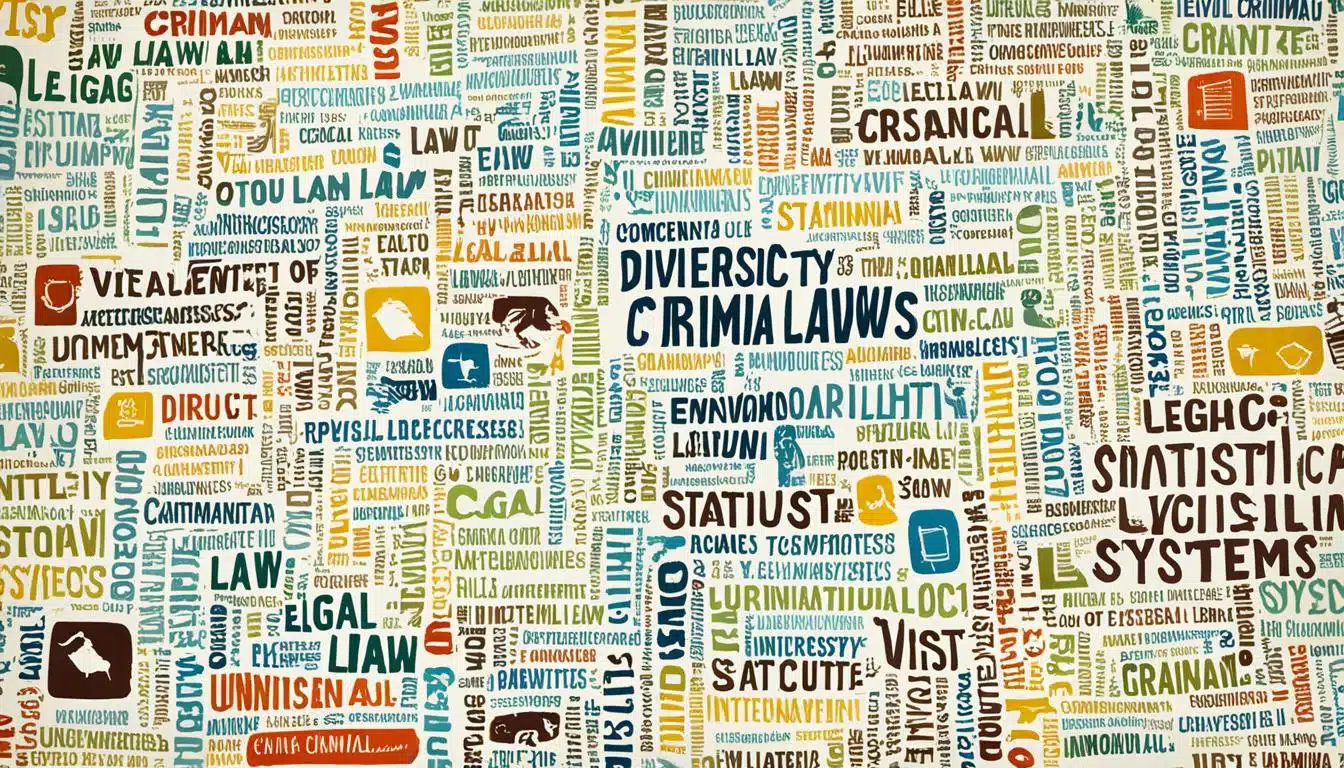The legal system in the United States is like a rich tapestry. It’s filled with many different laws that cover every part of our lives. From civil law to criminal law, constitutional law to administrative law, our society’s rules are wide-reaching and connected. This article gives a wide look at the various types of laws and legal systems in America.
In the civil law system, laws deal with how people interact. This includes contract law and tort law. In contrast, criminal law focuses on bad actions and punishes offenders. Constitutional law forms our government’s basis. Administrative law regulates the government’s activities. International law manages world relations, and property law is about ownership.
Family law handles affairs within families. Labor and employment law secures the rights and duties of working people. Environmental law is focused on protecting the natural world. Corporate law looks at the legalities of businesses. Intellectual property law protects new ideas and creations. Tax law creates rules for payment.
Additionally, immigration law controls who comes and stays in the U.S. Health law deals with legal aspects of healthcare. Cyber law addresses online legal matters. Bankruptcy law aids in the case of financial collapse. Securities law manages financial markets.
Also Read : How To File Injury Claims With Justice Law
Key Takeaways
- The United States legal system encompasses a diverse array of laws, including civil, criminal, constitutional, administrative, and international law.
- Key areas of law include contract, tort, property, family, labor, environmental, corporate, intellectual property, tax, immigration, health, cyber, bankruptcy, and securities law.
- Understanding the different types of laws and legal systems is crucial for navigating the complex legal landscape in the United States.
- The article provides a comprehensive overview of the various legal domains that shape and regulate different aspects of American society.
- By exploring the different types of laws, readers can gain a deeper understanding of the legal framework that governs their rights, obligations, and interactions within the United States.
Introduction to Laws
Laws in the world are mainly divided into two kinds: common law and civil law. It’s important to know the history and main points of these laws. This helps us understand the many statutory laws and regulatory laws that rule our lives now.
Also Read : Importance Of Studying Laws
The Common Law Tradition
The common law tradition started in England during the Middle Ages. It then spread to British colonies around the world. In this system, court decisions in past cases are very important for deciding new cases with the same issues. Judges play a big part in telling what the law means and how it should be used. There’s not one big book of laws that covers everything.
The Civil Law Tradition
The civil law tradition gets its roots from Europe around the same time as common law tradition. It was used in colonies of European imperial powers like Spain and Portugal. Civil law is written down in detailed codes. Judges mainly find out the facts of a case and then use these codes to decide what happens. Their job is not to make new laws through their decisions.
Many countries later adopted the civil law system. This includes places like Russia and Japan. They did this to become as strong as Western Europe economically and politically in the 1800s and 1900s.
Learning about these two legal traditions will help us understand the types of laws we see in the United States today.
Also Read : The Role Of Justice Law In Prosecution
Civil Law
Civil law goes back to the old Roman legal system. The term “civil law” comes from the Latin “ius civile,” meaning the law for all Roman citizens. In the sixth century CE, Emperor Justinian asked for a big set of laws to be made. This became the Corpus Iuris Civilis, a major work. It created the base for teaching and studying law in Europe.
Also Read : Guide To Legal Education
Origins of Civil Law
The Corpsus Iuris Civilis was found again in the eleventh century. It started being used for teaching law in Italy. Legal experts in Europe then began to adapt these old Roman laws. They made changes to fit their own society’s needs. This began the civil law tradition that influences many legal systems today.
Codification of Civil Law
In civil law, making a clear legal code is very important. These codes are the result of a lot of legal work. They are organized and detailed. This makes it easier to know and use the law. In a civil law system, judges decide cases using these laws.
Role of Judges in Civil Law
Compared to common law, judges in civil law don’t make as many new rules through their decisions. They work to understand a case’s facts. Then they apply the law that already exists. The main job of changing and explaining the law is left to lawmakers and legal thinkers. They keep updating the big legal guides.
Also Read : Understanding Justice In Criminal Law
Common Law
The journey of English common law is truly interesting. It has deeply influenced the legal system in the United States. After 1066, when the Normans conquered England, the kings started to build their power. They set up new royal courts for justice. From this, the common law was born. It’s a system of law based on court rulings and past decisions.
Historical Development of English Common Law
In the Middle Ages, the English common law grew stronger with the power of the crown. The monarch created writs, which were legal actions for different wrongs. But this system was too strict to bring real fairness.
This led to courts of equity opening. These courts looked for fair solutions by using various laws, like Roman and natural laws. They aimed to make sure justice was truly served.
Triumph of Common Law over Other Laws
For a long time, common law worked with other legal systems in England. But by the 17th century, common law had won. It became the main legal system in England and later the United States too. This was a key moment in English legal history.
Types Of Laws
The United States legal system has a wide range of types of laws and legal systems that govern society. These include criminal, civil, constitutional, and administrative laws. Each one is vital for upholding the nation’s legal structure and keeping order.
Criminal law outlines and punishes activities harmful to society, like murder and theft. Civil law focuses on individual legal relations, handling issues such as contracts and property rights. Constitutional law sets up the government’s basic framework, defining the power of different authorities.
Administrative law oversees public agencies and their dealings with citizens. International law, on the other hand, manages worldwide relations between countries. Contract law enforces promises and duties, and tort law covers civil offenses, offering solutions for damages done to people.
There’s also property law, which defines ownership of physical and personal properties. Family law tackles legal matters within families. Labor and employment law focuses on the rights and duties of workers and their employers.
Environmental law aims to preserve natural resources. Corporate law is all about the legal aspects of business work. Intellectual property law protects creative works and innovations.
Tax law lays down the rules on taxing people and businesses. Immigration law controls who can enter the country and stay. Health law covers the legal sides of healthcare. Cyber law deals with legal issues online. Bankruptcy law helps with payment issues.
This broad array of laws is crucial for keeping American society stable. They make sure the rights and responsibilities of everyone, from individuals to large organizations, are respected. Knowing how these laws work together is key for understanding the U.S. legal system.
Criminal Law
Criminal law is an essential part of our legal system. It deals with key issues of the law and our personal freedoms. Lawyers in this area are critical for protecting rights important for a free and fair society. There are two kinds of lawyers in criminal law: those who defend the accused, and those who prosecute.
Criminal Defense Lawyers
Criminal defense lawyers are on the side of those accused of crimes. They fight hard for their client’s rights, ensuring they get a fair process. These attorneys do their best to shield their clients from unfair prosecution. They look into the case details, and work out solid legal plans. Their goal is to get the best possible result for their clients, like lowering charges or proving innocence.
Prosecutors and District Attorneys
Prosecutors and district attorneys, on the other hand, represent the state. Their job is to hold those accused of crimes accountable. They review evidence, decide if charges should be brought, and argue the government’s case in court. These legal professionals team up with the police to create strong cases. Their work helps maintain order, keeping the community safe.
Civil Law (Different from Civil Law Tradition)
Civil law, in a broader sense, deals with legal ties between people, like contracts and tort law. It looks into these areas, vital for how people interact and solve problems within a civil law system.
Contracts
Contract law is about the promises and deals by which parties are legally bound. It keeps the promises safe and makes sure agreements are kept. Understanding contract law is crucial for attorneys helping with various deals and matters, from businesses to buying homes.
Tort Law
Tort law, on the other hand, deals with wrongs in civil aspects. It focuses on negligence and care duties, aiming to compensate the victim for any kind of injury. This branch of civil law is key in making sure individuals or groups take responsibility for the harm they cause unintentionally. Lawyers in this area either help the injured victim get justice or defend those who are alleged to have caused injury.
| Contract Law | Tort Law |
|---|---|
| Focuses on the legal agreements and obligations between parties | Addresses civil wrongs and provides remedies for harms caused by one party to another |
| Upholds the sanctity of promises and ensures the enforcement of bargains | Regulates private interactions and holds individuals or organizations accountable for their actions or inactions that result in foreseeable harm |
| Outlines the rights, responsibilities, and remedies available to each party in a transaction or relationship | Focuses on the duty of care, negligence, and the compensation of victims for injuries, whether physical, emotional, or economic |
Family and Juvenile Law
Family and juvenile law is very important. It looks at the complex connections in families. This includes things like adoptions, divorce, and child custody. The lawyers here handle cases that are about starting families, ending them, and the rights and duties within them.
Adoptions
The process of adopting someone can be hard. It involves a lot of emotions and laws. Family and juvenile lawyers help with all the legal work, make sure everything is done right, and look out for the kids and the new families they’re joining.
Divorce
Ending a marriage is tough and can be sensitive. Lawyers in family and juvenile law help navigate through divorce. They help figure out who gets what, who gets support, and how kids will be cared for. Their job is to make sure things are fair and just for everyone.
Child Custody
Deciding on child custody is very crucial. The lawyers work on cases about where and how kids will live. They help with things like when parents can visit and who makes what decisions for the child. Making sure kids are safe and happy is their top priority.
Business and Corporate Law
Corporate law is key in the business world’s legal side. It helps companies with everything, from starting to merging. Corporate lawyers make sure their clients do business right and by the law.
Corporate Formation
The first big step for a company is getting started legally. Corporate lawyers know this step well. They write the articles for starting the business and get the needed papers. This sets the business up correctly for future success.
Mergers and Acquisitions
Mergers and acquisitions are important parts of business law. Corporate lawyers guide companies through these big deals. They help with the legal parts and making the deals work. These lawyers are vital for business growth and new ideas.
| Practice Area | Key Responsibilities |
|---|---|
| Corporate Formation | Drafting articles of incorporation, securing licenses and permits, ensuring compliance with legal requirements |
| Mergers and Acquisitions | Identifying potential targets, negotiating deal terms, conducting due diligence, facilitating strategic business combinations |
Also Read : 10 Books Every Law Student Must Explore
Conclusion
We explored the types of laws and legal systems in the United States. We touched on everything from common law and civil law to statutory laws and regulatory laws. This journey showed us the rich complexity of our nation’s legal system.
It’s important to understand civil law, criminal law, and constitutional law. Knowing these areas helps us in our daily lives. We learn how laws protect our rights and shape society.
Our study highlights the importance of knowing types of laws. This knowledge is key for everyone. It helps us make smart choices, know our rights, and build a just society. Legal understanding is empowering.
FAQs
What are the different types of laws governing society in the United States?
There are many types of laws in the U.S., each covering different areas. For example, we have civil law, which deals with private disputes. Then, there’s constitutional law, which focuses on the nation’s founding rules. Additionally, criminal law handles offenses against the state.
Other areas include family law, which looks at domestic issues. Labor laws control the relationships between workers and their employers. Environmental law protects our planet, while bankruptcy law helps financially troubled individuals or companies.
What are the two major legal traditions followed by most nations today?
The world mainly follows two legal traditions. The common law tradition started in England. It relies on court decisions and interpretations of statutes. The civil law tradition, shaped by Roman law, is the basis for legal systems in many other countries.
What is the origin and model of the civil law tradition?
The civil law tradition draws from Roman law. Known as “ius civile,” it was the law for all Roman citizens. Its foundation is the Corpus Iuris Civilis, a set of legal texts put together at the order of Emperor Justinian in the 6th century.
How did the English common law system develop?
English common law grew through royal decisions in the Middle Ages. It started forming after the Norman Conquest in 1066. Kings began to unify and strengthen their rule, creating courts and systems to administer justice.
What are the key characteristics of criminal law and the different types of criminal law practitioners?
Criminal law concerns offenses against society. Its professionals include defense attorneys, helping accused individuals, and prosecutors, acting for the state. They argue cases in court, seeking fair outcomes for all involved.
What are the key aspects of civil law, as distinct from the civil law tradition?
Civil law tradition differs from civil law itself, which focuses on private relationships. Contract law governs agreements between parties. Meanwhile, tort law manages personal wrongs, aiming to make things right for those affected.
What are the common practice areas in family and juvenile law?
In family and juvenile law, lawyers often handle adoptions and divorce. They also look into child custody and support. Their work is about family legal matters, including marriage formations and closure.
What are the key practice areas within business and corporate law?
In business law, corporate formation and merging are critical areas. Corporate lawyers guide clients through these big deals. They help businesses operate legally and combine forces where needed.












